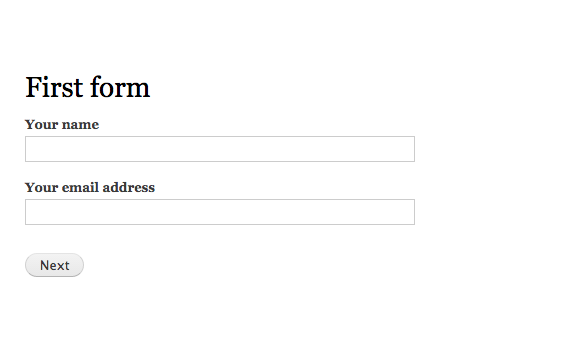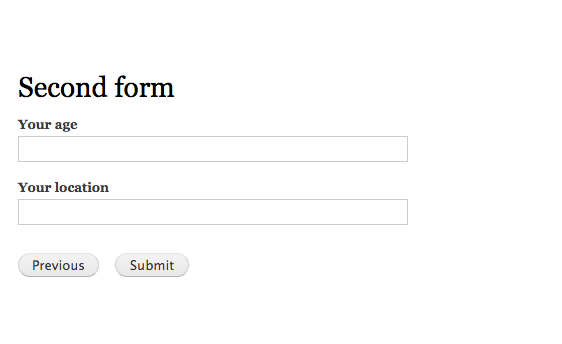In this article, we are going to look at building a multistep form in Drupal 8. For brevity, the form will have only two steps in the shape of two completely separate forms. To persist values across these steps, we will use functionality provided by Drupal’s core for storing temporary and private data across multiple requests.

In Drupal 7, a similar approach can be achieved using the cTools object cache. Alternatively, there is the option of persisting data through the $form_state array as illustrated in this tutorial.
The code we write in this article can be found in this repository alongside much of the Drupal 8 work we’ve been doing so far. We will be dealing with forms quite a lot so I do recommend checking out one of the previous articles on Drupal 8 in which we talk about forms.
The plan
As I mentioned above, our multistep form will consist of two independent forms with two simple elements each. Users will be able to fill in the first one and move to the second form where they can either go back to the previous step or fill it in and press submit. While navigating between the different steps, the previously submitted values are stored and used to pre-populate the form fields. If the last form is submitted, however, the data gets processed (not covered in this article) and cleared from the temporary storage.
Technically, both of these forms will inherit common functionality from an abstract form class we will call MultistepFormBase. This class will be in charge of injecting the necessary dependencies, scaffolding the form, processing the end result and anything else that is needed and is common to both.
We will group all the form classes together and place them inside a new folder called Multistep located within the Form plugin directory of our demo module (next to the old DemoForm). This is purely for having a clean structure and being able to quickly tell which forms are part of our multistep form process.
The code
We will start with the form base class. I will explain what is going on here after we see the code.
MultistepFormBase.php:
/**
* @file
* Contains \Drupal\demo\Form\Multistep\MultistepFormBase.
*/
namespace Drupal\demo\Form\Multistep;
use Drupal\Core\Form\FormBase;
use Drupal\Core\Form\FormStateInterface;
use Drupal\Core\Session\AccountInterface;
use Drupal\Core\Session\SessionManagerInterface;
use Drupal\user\PrivateTempStoreFactory;
use Symfony\Component\DependencyInjection\ContainerInterface;
abstract class MultistepFormBase extends FormBase {
/**
* @var \Drupal\user\PrivateTempStoreFactory
*/
protected $tempStoreFactory;
/**
* @var \Drupal\Core\Session\SessionManagerInterface
*/
private $sessionManager;
/**
* @var \Drupal\Core\Session\AccountInterface
*/
private $currentUser;
/**
* @var \Drupal\user\PrivateTempStore
*/
protected $store;
/**
* Constructs a \Drupal\demo\Form\Multistep\MultistepFormBase.
*
* @param \Drupal\user\PrivateTempStoreFactory $temp_store_factory
* @param \Drupal\Core\Session\SessionManagerInterface $session_manager
* @param \Drupal\Core\Session\AccountInterface $current_user
*/
public function __construct(PrivateTempStoreFactory $temp_store_factory, SessionManagerInterface $session_manager, AccountInterface $current_user) {
$this->tempStoreFactory = $temp_store_factory;
$this->sessionManager = $session_manager;
$this->currentUser = $current_user;
$this->store = $this->tempStoreFactory->get('multistep_data');
}
/**
* {@inheritdoc}
*/
public static function create(ContainerInterface $container) {
return new static(
$container->get('user.private_tempstore'),
$container->get('session_manager'),
$container->get('current_user')
);
}
/**
* {@inheritdoc}.
*/
public function buildForm(array $form, FormStateInterface $form_state) {
// Start a manual session for anonymous users.
if ($this->currentUser->isAnonymous() && !isset($_SESSION['multistep_form_holds_session'])) {
$_SESSION['multistep_form_holds_session'] = true;
$this->sessionManager->start();
}
$form = array();
$form['actions']['#type'] = 'actions';
$form['actions']['submit'] = array(
'#type' => 'submit',
'#value' => $this->t('Submit'),
'#button_type' => 'primary',
'#weight' => 10,
);
return $form;
}
/**
* Saves the data from the multistep form.
*/
protected function saveData() {
// Logic for saving data goes here...
$this->deleteStore();
drupal_set_message($this->t('The form has been saved.'));
}
/**
* Helper method that removes all the keys from the store collection used for
* the multistep form.
*/
protected function deleteStore() {
$keys = ['name', 'email', 'age', 'location'];
foreach ($keys as $key) {
$this->store->delete($key);
}
}
}Our abstract form class extends from the default Drupal FormBase class so that we can use some of the functionality made available by it and the traits it uses. We are using dependency injection to inject some of the needed services:
PrivateTempStoreFactorygives us a temporary store that is private to the current user (PrivateTempStore). We will keep all the submitted data from the form steps in this store. In the constructor, we are also immediately saving thestoreattribute which contains a reference to themultistep_datakey/value collection we will use for this process. Theget()method on the factory either creates the store if it doesn’t exist or retrieves it from the storage.- The
SessionManagerallows us to start a session for anonymous users. - The
CurrentUserallows us to check if the current user is anonymous.
Inside the buildForm() method we do two main things. First, we start a session for anonymous users if one does’t already exist. This is because without a session we cannot pass around temporary data across multiple requests. We use the session manager for this. Second, we create a base submit action button that will be present on all the implementing forms.
The saveData() method is going to be called from one or more of the implementing forms and is responsible with persisting the data from the temporary storage once the multistep process is completed. We won’t be going into the details of this implementation because it depends entirely on your use case (e.g. you can create a configuration entity from each submission). We do, however, handle the removal of all the items in the store once the data has been persisted. Keep in mind though that these types of logic checks should not be performed in the base class. You should defer to a dedicated service class as usual, or use a similar approach.
Now it’s time for the actual forms that will represent steps in the process. We start with the first class inside a file called MultistepOneForm.php:
/**
* @file
* Contains \Drupal\demo\Form\Multistep\MultistepOneForm.
*/
namespace Drupal\demo\Form\Multistep;
use Drupal\Core\Form\FormStateInterface;
class MultistepOneForm extends MultistepFormBase {
/**
* {@inheritdoc}.
*/
public function getFormId() {
return 'multistep_form_one';
}
/**
* {@inheritdoc}.
*/
public function buildForm(array $form, FormStateInterface $form_state) {
$form = parent::buildForm($form, $form_state);
$form['name'] = array(
'#type' => 'textfield',
'#title' => $this->t('Your name'),
'#default_value' => $this->store->get('name') ? $this->store->get('name') : '',
);
$form['email'] = array(
'#type' => 'email',
'#title' => $this->t('Your email address'),
'#default_value' => $this->store->get('email') ? $this->store->get('email') : '',
);
$form['actions']['submit']['#value'] = $this->t('Next');
return $form;
}
/**
* {@inheritdoc}
*/
public function submitForm(array &$form, FormStateInterface $form_state) {
$this->store->set('email', $form_state->getValue('email'));
$this->store->set('name', $form_state->getValue('name'));
$form_state->setRedirect('demo.multistep_two');
}
}This form will look something like this:

In the buildForm() method we are defining our two dummy form elements. Do notice that we are retrieving the existing form definition from the parent class first. The default values for these fields are set as the values found in the store for those keys (so that users can see the values they filled in at this step if they come back to it). Finally, we are changing the value of the action button to Next (to indicate that this form is not the final one).
In the submitForm() method we save the submitted values to the store and then redirect to the second form (which can be found at the route demo.multistep_two). Keep in mind that we are not doing any sort of validation here to keep the code light. But most use cases will call for some input validation.
Since we’ve touched upon the issue of routes, let’s update the route file in our demo module and create two new routes for our forms:
demo.routing.yml:
demo.multistep_one:
path: '/demo/multistep-one'
defaults:
_form: '\Drupal\demo\Form\Multistep\MultistepOneForm'
_title: 'First form'
requirements:
_permission: 'access content'
demo.multistep_two:
path: '/demo/multistep-two'
defaults:
_form: '\Drupal\demo\Form\Multistep\MultistepTwoForm'
_title: 'Second form'
requirements:
_permission: 'access content'For more information about what is going on in this file you can read one of the previous Drupal 8 articles which explain routes as well.
Finally, we can create our second form (inside a file called MultistepTwoForm):
/**
* @file
* Contains \Drupal\demo\Form\Multistep\MultistepTwoForm.
*/
namespace Drupal\demo\Form\Multistep;
use Drupal\Core\Form\FormStateInterface;
use Drupal\Core\Url;
class MultistepTwoForm extends MultistepFormBase {
/**
* {@inheritdoc}.
*/
public function getFormId() {
return 'multistep_form_two';
}
/**
* {@inheritdoc}.
*/
public function buildForm(array $form, FormStateInterface $form_state) {
$form = parent::buildForm($form, $form_state);
$form['age'] = array(
'#type' => 'textfield',
'#title' => $this->t('Your age'),
'#default_value' => $this->store->get('age') ? $this->store->get('age') : '',
);
$form['location'] = array(
'#type' => 'textfield',
'#title' => $this->t('Your location'),
'#default_value' => $this->store->get('location') ? $this->store->get('location') : '',
);
$form['actions']['previous'] = array(
'#type' => 'link',
'#title' => $this->t('Previous'),
'#attributes' => array(
'class' => array('button'),
),
'#weight' => 0,
'#url' => Url::fromRoute('demo.multistep_one'),
);
return $form;
}
/**
* {@inheritdoc}
*/
public function submitForm(array &$form, FormStateInterface $form_state) {
$this->store->set('age', $form_state->getValue('age'));
$this->store->set('location', $form_state->getValue('location'));
// Save the data
parent::saveData();
$form_state->setRedirect('some_route');
}
}This one will look like this, again very simple:

Again, we are extending from our base class like we did with the first form. This time, however, we have different form elements and we are adding a new action link next to the submit button. This will allow users to navigate back to the first step of the form process.
Inside the submitForm() method we again save the values to the store and defer to the parent class to persist this data in any way it sees fit. We then redirect to whatever page we want (the route we use here is a dummy one).
And that is pretty much it. We should now have a working multistep form that uses the PrivateTempStore to keep data available across multiple requests. If we need more steps, all we have to do is create some more forms, add them in between the existing ones and make a couple of adjustments. Of course you can make this much more flexible by not hardcoding the route names in the links and redirects, but I leave that part up to you.
Conclusion
In this article, we looked at a simple way to create a multistep form in Drupal 8. You can, of course, build on this approach and create highly complex and dynamic processes that involve not just forms but also other kinds of steps that leverage cross-request data. Thus, the purpose of this article has been as much about multistep forms as it has been about illustrating the power of the PrivateTempStore. And if you, like me, think that the cTools object cache is very powerful in Drupal 7, you’ll be very invested in its Drupal 8 counterpart.
Frequently Asked Questions on Building Multi-Step Forms in Drupal 8
What are the prerequisites for creating a multi-step form in Drupal 8?
Before you start creating a multi-step form in Drupal 8, you need to have a basic understanding of Drupal 8’s Form API. This API allows you to create, customize, and manage forms in Drupal 8. You should also be familiar with PHP and HTML as these languages are used in the creation and customization of forms. Additionally, you need to have Drupal 8 installed on your system.
How can I create a custom multi-step form in Drupal 8?
Creating a custom multi-step form in Drupal 8 involves several steps. First, you need to create a custom module and define a route for your form. Then, you create a form class that extends FormBase and implement the necessary methods. You can then define your form fields and handle form submission. To make the form multi-step, you need to use the form storage to store data between steps and define a different form state for each step.
Can I use contributed modules to create multi-step forms in Drupal 8?
Yes, there are several contributed modules available that can simplify the process of creating multi-step forms in Drupal 8. Some of these modules include Simple Multistep, Multistep Form Framework, and CTools Wizard. These modules provide a framework for creating multi-step forms and can save you a lot of time and effort.
How can I handle form validation in a multi-step form in Drupal 8?
Form validation in a multi-step form in Drupal 8 can be handled using the validateForm method. This method is called when the form is submitted and can be used to check the values entered by the user. If there are any errors, you can set an error message using the form state’s setErrorByName method.
How can I handle form submission in a multi-step form in Drupal 8?
Form submission in a multi-step form in Drupal 8 can be handled using the submitForm method. This method is called when the final step of the form is submitted. You can use this method to save the data entered by the user or perform any other actions required.
Can I use AJAX in a multi-step form in Drupal 8?
Yes, you can use AJAX in a multi-step form in Drupal 8 to update parts of the form without refreshing the entire page. This can be done using the ajax property of the form element. You can specify a callback function that will be called when the element is triggered.
How can I customize the appearance of a multi-step form in Drupal 8?
The appearance of a multi-step form in Drupal 8 can be customized using CSS. You can add a custom CSS file to your module and use it to style your form. You can also use Drupal 8’s Twig templating system to customize the HTML of your form.
How can I add a progress bar to a multi-step form in Drupal 8?
Adding a progress bar to a multi-step form in Drupal 8 can be done using the form API’s #progress_bar property. This property allows you to specify a progress bar that shows the user their progress through the form.
Can I create a multi-step form with conditional fields in Drupal 8?
Yes, you can create a multi-step form with conditional fields in Drupal 8. This can be done using the form API’s #states property. This property allows you to specify conditions that determine whether a form element is visible or not.
How can I debug a multi-step form in Drupal 8?
Debugging a multi-step form in Drupal 8 can be done using various tools and techniques. One of the most common methods is to use the Devel module, which provides a suite of debugging tools. You can also use PHP’s var_dump function to output the values of variables at different points in your code.
 Daniel Sipos
Daniel SiposDaniel Sipos is a Drupal developer who lives in Brussels, Belgium. He works professionally with Drupal but likes to use other PHP frameworks and technologies as well. He runs webomelette.com, a Drupal blog where he writes articles and tutorials about Drupal development, theming and site building.

